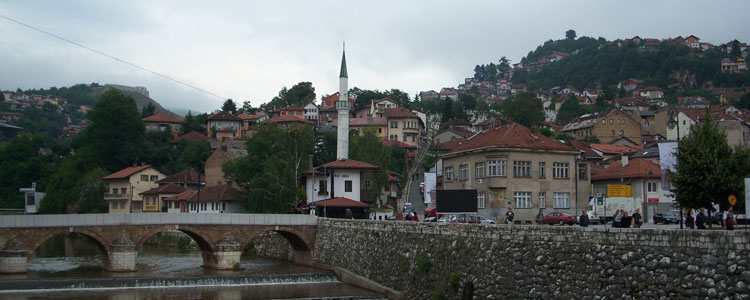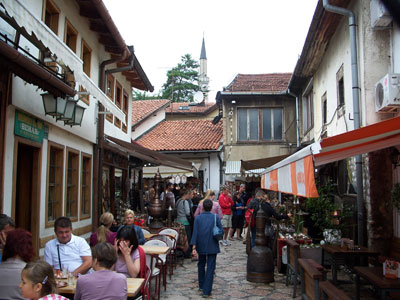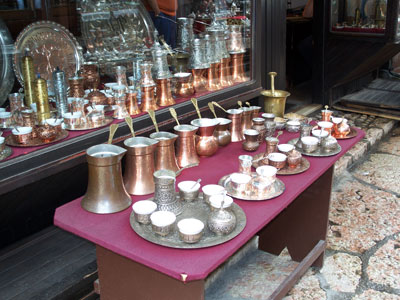Sarajevo—shedding its troubled past for a more promising future
by Deanna Palić; Contributing Editor
Films, for me, are a form of escape and relaxation. As a devoted film buff, I am that lonely figure who remains in the theater until the last credit has rolled.
Filming locations often influence my decision of where I will travel next. In 2011 it was a film starring Richard Gere called “The Hunting Party,” with several scenes filmed in the oldest section of Sarajevo, that lured me to Bosnia-Herzegovina in July. I had no idea that the Sarajevo Film Festival would also be in progress during my visit.
Established in 1995, the Sarajevo Film Festival is the premier film festival in the Balkans and one of the largest in Europe. It shows a selection of the most interesting and successful achievements of independent motion picture production from all over the world.
Morgan Freeman was a guest of honor in 2010, and in 2011 Angelina Jolie was presented with an honorary Heart of Sarajevo Award.
Jetting there
Securing a workable itinerary through United’s MileagePlus frequent-flyer program was a fierce battle. My quest began in February, and a satisfactory result was achieved less than two weeks prior to my departure.
From Los Angeles I traveled on Lufthansa to Zagreb, Croatia. I found Lufthansa’s economy-class service to be a real treat compared to those of US carriers. Cocktails and snacks were available in the galley for the entire flight.
I joined my husband, Josip, in Zagreb for a few days of catching up with family and friends and indulging in some good food. We then flew nonstop to Sarajevo with Star Alliance member Croatia Airlines. Their equipment was new and clean, and the service was as good as it gets on a brief one-hour flight.
A long history
Sarajevo, nestled in a valley stretching east and west along the banks of the Miljacka River, has a population of around 400,000. We took a walking tour of the city with a freelance guide arranged through the tourist office ($15 per person); however, free walking tours are also available (gratuities are appreciated).
Our excellent guide, Berina Karačić, informed us that Sarajevo has always connected the East and the West. Its unique blend of history, culture and heritage contributes to Sarajevo’s being called the European Jerusalem. In Baščaršija, the heart of the old part of the city, it is not unusual to find mosques, a synagogue, a Roman Catholic cathedral and a Serbian Orthodox church close together.
The magnificent Gazi Husrev-bey Mosque, the most important Islamic building in Bosnia, is one of the finest examples of Ottoman architecture in the world. Its minaret towers over the mosque’s dome and the surrounding area. The grounds include a washing room, a wooden fountain, a primary school and the prayer caller’s home plus two elaborate 16th-century tombs.
In El Cortijo, an area on the outskirts of Baščaršija, is the Old Synagogue. Originally built in 1581, it burned down and was rebuilt twice. Today it houses the Jewish Museum. Next door is the New Synagogue, home to an art gallery owned by the city’s Jewish community.
Also of interest among the city’s sights is the Latin Bridge, where bullets fired on a Sarajevo street on a sunny 1914 June morning set in motion a series of events that shaped the world we live in today.
The victims, Archduke Franz Ferdinand, heir to the throne of the Austro-Hungarian Empire, and his wife, Sophie, were in Sarajevo in conjunction with Austrian troop exercises nearby.
The assassin, 19-year-old Gavrilo Princip, envisioned the death of the Archduke as the key that would unlock the shackles binding his people to the Austro-Hungarian Empire.
The Balkan region of Europe entered the 20th century much as she left it, a cauldron of seething political intrigue needing only the slightest increase in heat to boil over into open conflict.
In the 1990s, the Siege of Sarajevo became a constant in the headlines, even in the US. Bosnian defense forces fighting off Serbs who wanted to acquire territory in Bosnia-Herzegovina after the country declared its independence from Yugoslavia were poorly equipped and unable to break the siege, which lasted from April 1992 to February 1996.
Bosnian cuisine
During our four days in Sarajevo, I accomplished my goal to consume as much burek and ćevapčići as possible. In Bosnia, if you order burek, a filled puff pastry, you are automatically served the meat-filled variety. If you are looking for one of the other varieties, known as pita, you must be specific; choose from spinach (zeljanica), cheese (sirnica), potato (krompirusa) or pumpkin (tikvenica).
Our favorite restaurant was Bosna (Bravadžiluk St. #11). Its long lines, when similar restaurants had empty tables, said it all.
Ćevapčići, also called ćevapi, are made from ground meat formed into briquette shapes and served on a bun. They are pretty much the same everywhere, the only difference being in the spices. I cannot remember ever having a ćevapčići that I didn’t like.
Josip’s tastes are more refined. When we dined at Sedef (Ferhadija 16; phone 033 200 588), he ordered Bosanski Lonac, defined on the menu as “Bosnian Pot.” I would call it a stew, made with either lamb or beef — quite delicious. Our dinner, with two Sarajevsko beers, came to $15, including tip. (Sedef does not accept credit cards.)
Accommodations
We had a double room at the cozy, 13-room Hotel Boutique 36 (fax +387 33 239 790), where we were hosted by the Tourism Association of Sarajevo Canton (Branilaca Sarajevo 21/4, 71 000 Sarajevo, Bosna i Hercegovina).
We were in room No. 22, one of six renovated rooms. The staff was efficient and friendly and could not have been more helpful.
The hotel will provide transportation from/to the airport for $9.50 per person, each way. However, if you book through their website and pay cash for your accommodations, airport transportation is complimentary.
Rates are very reasonable ($74 single, $94 double or, for a studio apartment suitable for four persons, $142). Included is an ample Continental breakfast, air-conditioning and Internet access.
From the hotel, it was a short downhill walk to the old part of the city and the bus stop. Shopping and restaurants can be found there among myriad pedestrian streets.
Several times a day when entering and leaving Stari Grad, the Old City, we passed Sebilj Fountain. When it wasn’t raining, we would make a rest stop on the fountain steps, a great spot from which to watch the blur of passersby and the flocks of pigeons that seem to call this area home. From there, there is a view of the dome and minaret of the Gazi Husrev-bey Mosque.
To give us a general layout of Sarajevo, our guide suggested we take bus No. 3. Its route basically circumvents the newer sections of the city as well as the Communist-era apartment blocks.
The Holiday Inn, located in the modern sector, is a 10-story structure built for the 1984 Winter Olympics in Sarajevo. It was the only hotel in the city that functioned during the war and one of the few buildings not to be bombed.
The main street in front of the hotel, also the main route to the airport, was known as “Sniper Alley.” Those using this thoroughfare were in imminent danger of being shot by snipers hiding in the surrounding hills as they assaulted and blockaded the entire city. The hotel, understandably, doesn’t make a big deal of its grisly history, but it is featured as part of all city tours.
Today, for the most part, Sarajevo has shed its ghosts. The traces of the devastation caused by the conflict have been effaced. The ruins of some buildings can still be seen, and the scars of bullet holes in others are reminders of its turbulent past. Sarajevo has made a substantial recovery in terms of the number of buildings that have been fully restored and reoccupied.
New construction projects and foreign investment have made Sarajevo perhaps the fastest-growing city in the former Yugoslavia, and its citizens look forward to a bright future.



